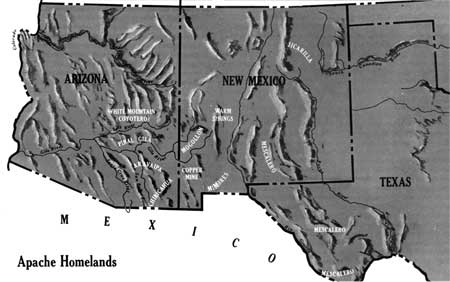|
FORT DAVIS National Historic Site |
 |

(click on image for an enlargement in a new window)
The Apaches
The Mescalero and Warm Springs Apaches against whom the Fort Davis troopers campaigned were but two of a dozen Apache tribes scattered from the Pecos to the middle Gila River as shown on this map. Before crushed and confined to reservations by the advancing American frontier, they roamed the Southwest and parts of northern Mexico. They were a nomadic people, subsisting on game, roots, and berries and living in brush shelters easily erected by the women at each stopping place. Although possessing common cultural traits, the various tribes had a few political or social bonds, and each normally acted independently of the others.
The warriors formed compact bands of raiders that regularly struck at the settlements of northern Mexico for stock, captives, and other plunder. Lightly equipped, highly mobile, each man possessed of courage, endurance, and complete mastery of guerilla tactics. Apache raiding parties proved the most formidable foes the Army encountered on the Indian frontier. The problem was not to defeat them in battle—although when cornered they were dangerous and ruthless adversaries—but to bring them to battle at all. Their habit was to avoid engagements where the odds were not overwhelmingly in their favor, and this they did skillfully and almost effortlessly. For soldiers of the Southwest, the Apaches were consisted mainly of endless marches under the desert sun, with rarely a chance to come to grips with the enemy.
Under such leaders as Victorio, Nana, Cochise, Mangas Coloradas, and Geronimo, the Apaches rose against the swelling tide of American immigration much as their fathers and grandfathers had risen against the Spaniards. The Apache wars began in New Mexico in the early 1850's and ended in Arizona with the surrender of Geronimo in 1886. The conquest was finally brought about more by psychological than by military means. Hounded persistently by army columns and confronted on every hand with evidence of the white man's numbers, power, and determination to take what he wanted, the Apache tribes, one after another, perceived the futility of continued resistance.

|
| History | Links to the Past | National Park Service | Search | Contact |
|
Last Modified: Fri, Oct 18 2002 10:00:00 pm PDT |


